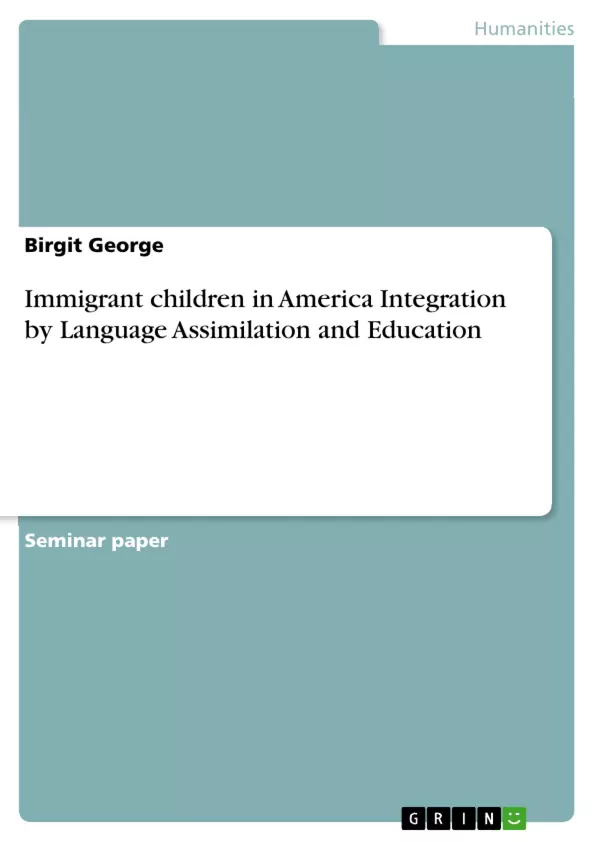During the work on my seminar paper in this seminar “Immigration Country: USA” – that
introduced modern conceptions of citizenship in the United States – I questioned the process
of naturalization as an instrument to integrate immigrants as well as the including language
test where immigrants must prove their ability to write, speak and read English. This theme
led me to the question if language works as an instrument for integration or exclusion in contemporary
multiethnic America - language and education, both very important for ones forthcoming
in a society.
In this homework I can only work on a small aspect on immigrant’s integration, so I
intend to follow the questions how well immigrant children adapt to their American host society
through schooling and the educational system and what role language assimilation plays in
the American society that undergoes a continuing flow of immigrants of diverse ethnicities.
Does the assimilation of the English language help for better integration, what does
integration mean in this special context and what impacts does it have on immigrant children?
What are their future prospects and is the common assumption true “no English language proficiency
– no integration – no success”? How does the nation, state or schools react on the
growing numbers of LEP students? I followed the pros and cons for bilingual classes and regarding
this context the English-only Movement and its demands of American schools and its
students. Immigration is once again transforming the racial as well as ethnic contours of American Society.
Current estimates place annual immigration to the United States (legal and undocumented)
at about 1 million persons per year (National Research Council 1997) and it won’t
take long until the European Americans will no longer be a majority but African Americans,
Latinos, Asians and Native Americans. This shift might be a beginning of a revolutionary
change in the relationship between the majority and minority Americans. Maybe that will be
an end to a social and cultural dominance of European-Americans and a flowering of multiculturalism. [...]
Inhaltsverzeichnis (Table of Contents)
- Introduction
- The Integration of Immigrants into the American Society
- Assimilation as Conception for Integration
- Language and Multiculturalism
- Language Assimilation and Biculturalism
- Language A Criterion for Exclusion?
- A Historical Overview: Testing Linguistic Proficiency
- English Proficiency on General Plane
- Immigrant Children in the United States
- Problems with Data Research
- Schooling and Educational Success of Immigrant Children
- Formal Education Institutions and the Media: Acquisition of Linguistic Proficiency
- Controvercies on Bilingual Classes and the English-Only Movement
- California A Case Study
- Proposition 227
- Conclusion
Zielsetzung und Themenschwerpunkte (Objectives and Key Themes)
This paper explores the integration of immigrant children into American society through the lens of language assimilation and education. It aims to examine the role of language proficiency in the adaptation process, exploring how the educational system and societal expectations impact immigrant children's success. The author investigates the controversies surrounding bilingual education and the English-Only movement, analyzing their potential effects on immigrant children.
- The impact of language assimilation on immigrant children's integration into American society
- The role of education in facilitating or hindering the integration of immigrant children
- The controversies surrounding bilingual education and the English-Only movement
- The challenges faced by immigrant children in acquiring English proficiency and navigating the American educational system
- The complex relationship between integration, assimilation, and multiculturalism in the context of American society
Zusammenfassung der Kapitel (Chapter Summaries)
The introduction sets the stage by discussing the changing demographics of American society and the growing importance of immigrant integration. It delves into the concept of assimilation as a model for integration, examining its limitations and exploring the nuances of incorporation as a more dynamic process.
The second chapter examines the relationship between language and multiculturalism, exploring the tension between language diversity and the expectation of English proficiency for successful integration. The historical use of language proficiency tests and the current debate on bilingual education are discussed.
Chapter three delves into the specific challenges faced by immigrant children in the United States, highlighting the complexities of data research and the need for a deeper understanding of their experiences.
The fourth chapter focuses on the role of schooling in facilitating the integration of immigrant children. It examines the acquisition of linguistic proficiency within formal education institutions and the controversial debate surrounding bilingual classes versus the English-Only movement.
Chapter five presents California as a case study, highlighting the impact of Proposition 227 on immigrant children's education and the ongoing debate surrounding language policy in the state.
Schlüsselwörter (Keywords)
This paper focuses on the key terms of immigrant children, language assimilation, integration, education, bilingual education, English-Only movement, multiculturalism, and American society. It examines the various aspects of these concepts in relation to the integration of immigrant children and the complex interplay of language, culture, and identity.
- Quote paper
- Birgit George (Author), 2003, Immigrant children in America Integration by Language Assimilation and Education, Munich, GRIN Verlag, https://www.grin.com/document/14092



